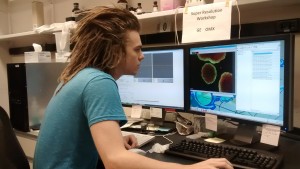by Taylor Meinhardt ’16
This summer I am doing research at the NIH (National Institutes of Health) under post-doc Sricharan Murugesan in Dr. John Hammer’s lab of the NHLBI (National Heart Lung and Blood Institute). My project is tied closely to the primary focus of Dr. Murugesan’s research and is related to a project he brought to Hampden-Sydney while working with Professor Mike Wolyniak’s Molecular Biology class last year.
Dr. Murugesan is trying to understand the formation and function of actin arcs at the immunological synapse (IS) of T Cells. Branched and linear actin filaments make up the cytoskeleton of cells, which undergoes rapid rearrangement in T Cells upon contact with target cell. These structures are also present in migrating cells, providing the possibility of implications far beyond T Cell biology. Using Structured Illumination Microscopy (a form of super resolution fluorescent microscopy), he has uncovered linear actin filaments that run perpendicular to the plasma membrane, and are embedded in the branched actin network at the periphery of the IS, and reorient into the concentric actin arcs in the interior. They believe these linear actin filaments are nucleated by forming, a class of proteins known to assemble free actin into filaments.
Using a Deltavision OMX microscope, I fluorescently stain the actin within Jurkat T cells, an immortal human cell line, as well as the formins INF2, mDia1, and FMNL1 in order to learn about their localization relative to these concentric, linear actin filaments at the IS. We will also transfect Jurkat cell lines with shRNA plasmids to knock down each of these protein products to observe their effect on the formation of the IS. This will help us infer about their specific roles and relative importance in the formation of this immunological structure.


